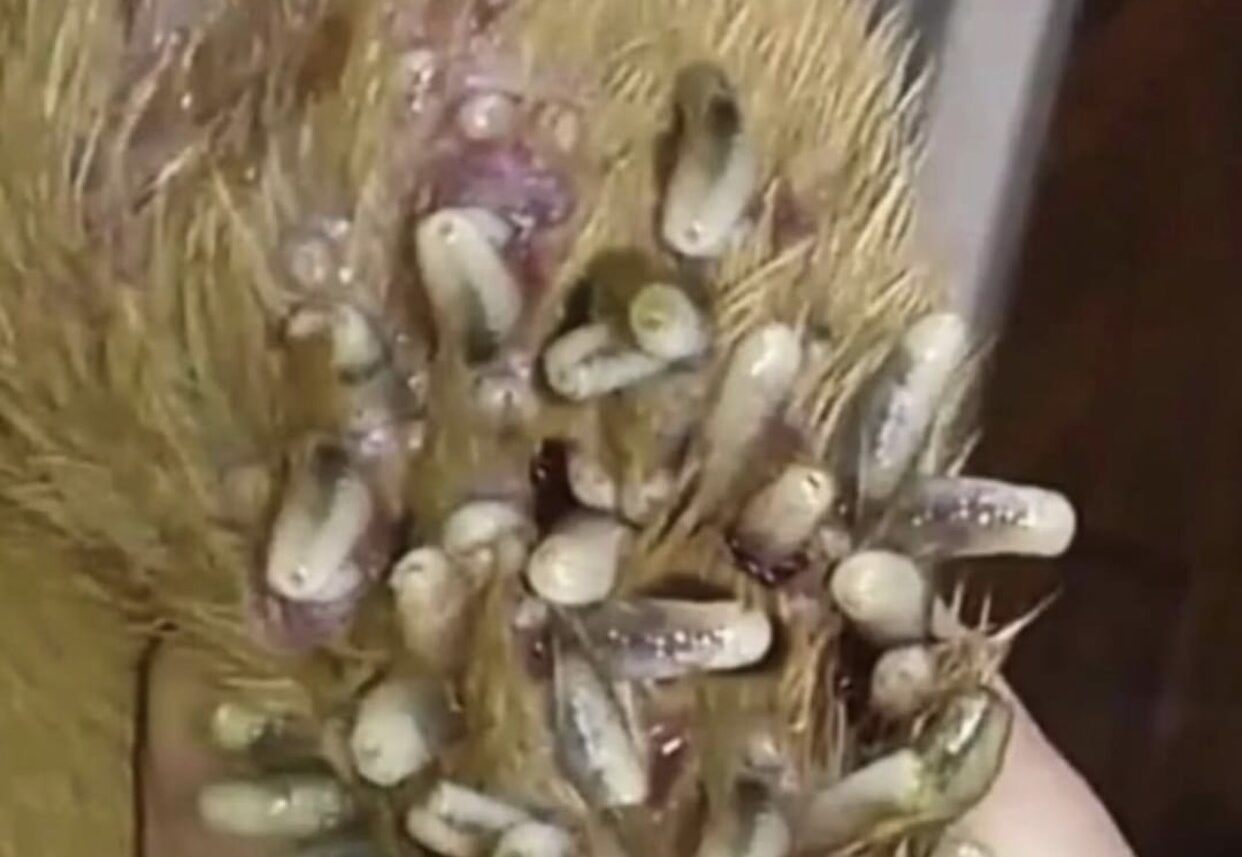See Video Below!
What is Myiasis (Maggots)?
Myiasis is an infestation of fly maggots or grubs on another living thing. This is more common in the warm summer months when flies are laying their eggs, and is much more prominent in hot, humid environments. Dogs with festering wounds, chronic skin problems, incontinence or mobility impairment issues are more likely to develop this disease. This is a serious condition and the removal of the maggots or grubs should be handled by a veterinary professional in order to avoid the release of dangerous enzymes and toxins into the dog’s bloodstream.
Myiasis is the medical term for an infestation of fly larvae, either maggots or grubs, on the skin of a living animal, in this case, a dog.
Symptoms of Myiasis (Maggots) in Dogs
The most visible sign of myiasis is unmistakable. The small, white larva of a fly will be present on the broken skin of the dog, and most often will be wriggling and moving. Sometimes the dog’s fur obscures the wound, particularly with long, matted fur. Miniscule sticky, white eggs can often be found on the fur of the afflicted animal. A dog with untreated myiasis will develop a foul, decaying smell as the maggots secrete an enzyme that necrotizes healthy skin tissues. In severe cases, they may lose their appetite as well as becoming lethargic and depressed.
Foul smell
Visisble larvae on skin
Lethargy
Types
Myiasis
This type of infestation is caused by an infestation of maggots, which is the larval stage of the growth of many flies. Pre-existing wounds and skin damage are susceptible to this type of infestation, and many maggots will be present with this type of infestation and it can lead to necrosis and additional infections.
Cuterebriasis
With cuterebriasis, the infestation is actually by the grub of a fly in the Cuterebra family. The female of the Cuterebra fly, also known as the botfly, lays her eggs on the ground near the homes of rodents such as rats or rabbits. They burrow into their host and grow until they emerge a month later. These grubs can be found either singly or in small groups, but are not generally found in the large number that the maggots of blowflies are.
Causes of Myiasis (Maggots) in Dogs
Myiasis is caused by a female fly, usually a blowfly, laying eggs in a festering wound, on areas of the skin that are consistently damp, or on areas of skin that are soiled by urine or feces. This is more likely to occur during the warmer months and in hot, moist environments. This occurs most commonly in dogs that are consistently dirty, who are seriously wounded, or have impaired mobility. Persistent skin infections or allergies can also increase the risk of maggot infestation.
Diagnosis of Myiasis (Maggots) in Dogs
Diagnosis of a blowfly maggot infestation is often much simpler than the task of treating it, as the maggots can clearly be seen in most wounds. The area will be shaved to give the examining veterinarian a better view of the affected tissues. In serious infestations, the wounds can extend further than it may appear due to the amount of necrotized flesh the maggots are creating. Cultures of any affected tissues will help to reveal if any bacterial or fungal infections are present in the wounds.
Botflies create a lump with a breathing hole on the surface of the skin as they grow. These breathing holes are usually visible when the area is shaved and occasionally the breathing tube of the grub itself can be seen poking out. In rare cases where the grub migrates into the lungs or brain diagnosis becomes more challenging and additional imaging techniques such as CT scans and magnetic resonance imaging may be helpful in spotting either the larvae or their migratory tracks.
Treatment of Myiasis (Maggots) in Dogs
The primary treatment of myiasis is the physical removal of the maggots or grubs. This process is usually done by hand and is a delicate procedure. With blowfly maggots there can be large numbers of the larvae, and they must all be removed. Often skin that has been damaged by the maggots needs to be debrided to remove dead tissue and promote healing.
Botfly grubs are usually only present as singletons or in small groups, but they too contain toxins within their bodies that can be detrimental to your pet’s health. Because of both the delicacy of the operation and to avoid discomfort on the part of the dog, it is usually done under sedation or general anesthesia. Any infections that are uncovered by the cultures taken of the infected tissues will be addressed at this time as well, and antibiotics or antifungals will be prescribed as needed.

